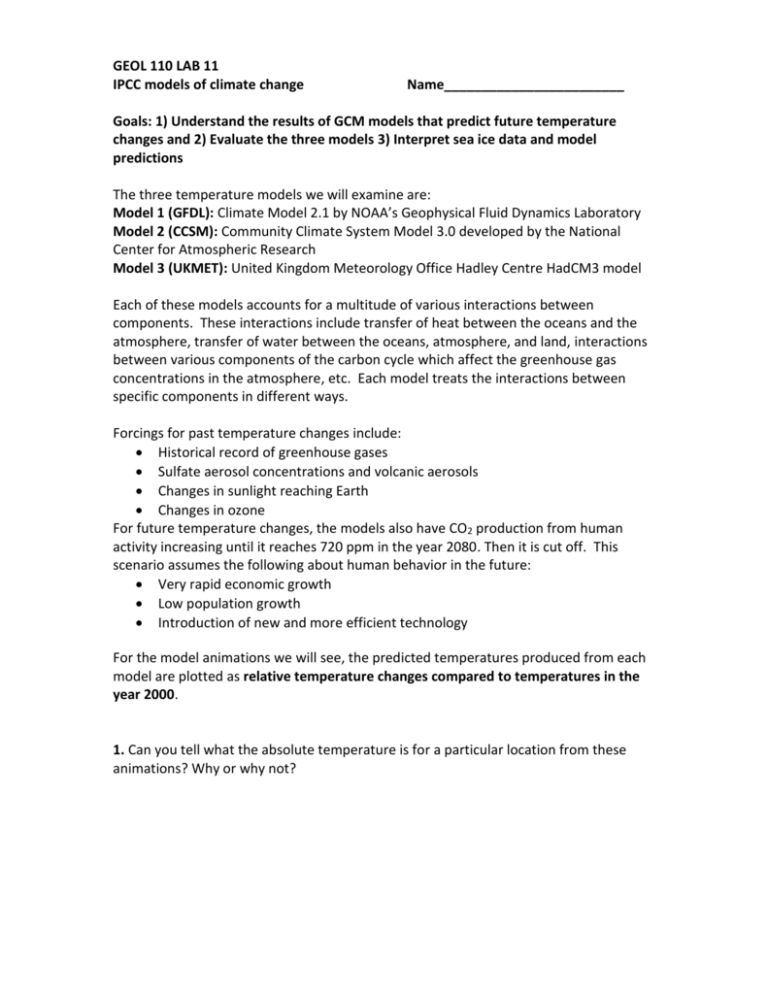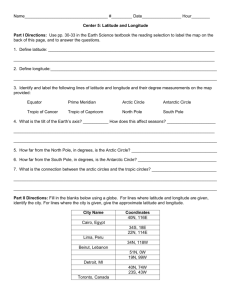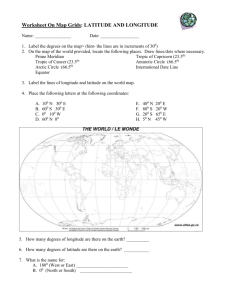IPCC models of temperature change 1870-2199
advertisement

GEOL 110 LAB 11 IPCC models of climate change Name________________________ Goals: 1) Understand the results of GCM models that predict future temperature changes and 2) Evaluate the three models 3) Interpret sea ice data and model predictions The three temperature models we will examine are: Model 1 (GFDL): Climate Model 2.1 by NOAA’s Geophysical Fluid Dynamics Laboratory Model 2 (CCSM): Community Climate System Model 3.0 developed by the National Center for Atmospheric Research Model 3 (UKMET): United Kingdom Meteorology Office Hadley Centre HadCM3 model Each of these models accounts for a multitude of various interactions between components. These interactions include transfer of heat between the oceans and the atmosphere, transfer of water between the oceans, atmosphere, and land, interactions between various components of the carbon cycle which affect the greenhouse gas concentrations in the atmosphere, etc. Each model treats the interactions between specific components in different ways. Forcings for past temperature changes include: Historical record of greenhouse gases Sulfate aerosol concentrations and volcanic aerosols Changes in sunlight reaching Earth Changes in ozone For future temperature changes, the models also have CO2 production from human activity increasing until it reaches 720 ppm in the year 2080. Then it is cut off. This scenario assumes the following about human behavior in the future: Very rapid economic growth Low population growth Introduction of new and more efficient technology For the model animations we will see, the predicted temperatures produced from each model are plotted as relative temperature changes compared to temperatures in the year 2000. 1. Can you tell what the absolute temperature is for a particular location from these animations? Why or why not? 2. For each model, record the temperature difference between the year 2000 and 2199 for each of these locations: Model 1 (GFDL) Model 2 (CCSM) Model 3 (UKMET) South Pole North Pole The Atlantic Ocean just south of Greenland Harrisonburg, VA The Pacific Ocean near Hawaii Global average (mean) warming 2000-2199 2.9C 2.7C 3.7C 3. Do the North and South Pole get warmer at the same rate? If they don’t, which one is predicted to undergo a more extreme temperature increase? 4. Compare the average temperature increase of the oceans to that of the continents: 5. Compare the average temperature increase of the continents to that of the average global temperature increase. Why are global averages sometimes misleading? 6. Why do you think we should care about temperature changes in the surface waters off of the coast of Greenland? Land (grid size) Atmosphere (grid size) Atmosphere: number of vertical layers Ocean (grid size) Oceans: number of vertical layers Ocean grid North Pole location Global mean warming 2000-2199 Model 1 (GFDL) 2 latitude by 2.5 longitude 2 latitude by 2.5 longitude ? Model 2 (CCSM) Model 3 (UKMET) 2.5 latitude by 2.8 latitude by 2.8 longitude 3.75 longitude 2.5 latitude by 2.8 latitude by 2.8 longitude 3.75 longitude ? 24 26 19 1 latitude by 1 longitude 50 (22 of these are thinner layers in the top 220 meters) 1 latitude by 1 longitude 1.25 latitude by 1.25 longitude 40 20 North America Greenland At correct geographic locationbut they put an island there! 2.9C 2.7C 3.7C 7. Based on the model grid size information in the chart above, which of these models has the worst resolution? What might this say about this model’s predictions? 8. Can you see any evidence of the grid used to do the calculations in any of these models? Which one, and what does it look like? Sea Ice Data: We will look at an animation of changes in sea ice from 1979-2004. The red outline represents the average amount of sea ice from 1979-2004 (for the entire year). The white color represents sea ice in September. 9. What is the general trend of the extent of sea ice in September? Sea Ice Models: We will look at a couple of models of future changes in sea ice. The first model was made by the GFDL group; the second was made by the Hadley (UKMET) group. 10. What do the black arrows mean? 11. Green colors represent sea ice- the thicker the ice, the darker green the color. What do the models predict will happen to sea ice near the North Pole? What about sea ice near the South Pole? Discussion question: 12. Should the government make laws to restrict greenhouse gas emissions based on the results from these computer models? Are we morally responsible for the state of the environment 40 years from now (grandkids)? What about 1000 years from now? References: CCSM 3.0 Models and documentation. http://www.ccsm.ucar.edu/models/ccsm3.0/ Cox et al. 1999 Climate Dynamics 15:183-203 (Land model for UKMET HadCM3) Delworth et al. 2006 Journal of Climate 19(5), 643-674 (GFDL CM2) Gordon et al. 2000 Climate Dynamics 16: 147-168 (UKMET HadCM3) Pope, V.D. et al. 2000: The impact of new physical parametrizations in the Hadley Centre climate model - HadAM3. Climate Dynamics 16:123-146 (Atmospheric model for UKMET HadCM3) GEOL 110 Name______________________ Lab 11 “Quiz” Due 12:30 PM on your last day of lab (April 22 or 24) Use the IPCC (Intergovernmental Panel on Climate Change) website to answer these questions: http://www.ipcc.ch/ 1. (3 points) In a few sentences, describe who makes up the IPCC and why it was created: 2. (6 points) The IPCC report is split into three parts, each made by a separate Working Group of scientists (I, II and III). In your own words, what broad topic did each Working Group cover in their report? Hint: click on the link for each part of the report at http://www.ipcc.ch/ipccreports/assessments-reports.htm and look at the chapter titles to see what’s covered in them. Working Group I: Working Group II: Working Group III: 3. (3 points) Go to the Summary for Policymakers for the Working Group I report: http://www.ipcc.ch/pdf/assessment-report/ar4/wg1/ar4-wg1-spm.pdf. Starting on p. 11, there is a list of future changes in climate. What words are italicized in some of the predictions? Why do you think these words are highlighted in this way, and how does this relate to the scientific method / a scientific way of thinking? (You may want to go back to the first class of the semester to look up notes on the scientific method). 4. (3 points) Go to the Working Group II report: http://www.ipcc.ch/ipccreports/ar4wg2.htm. Click on one or more of the chapters and read a few sections until you find something interesting about climate change that you’ve never heard of before. What chapter did you use? What interesting conclusions did you find?









